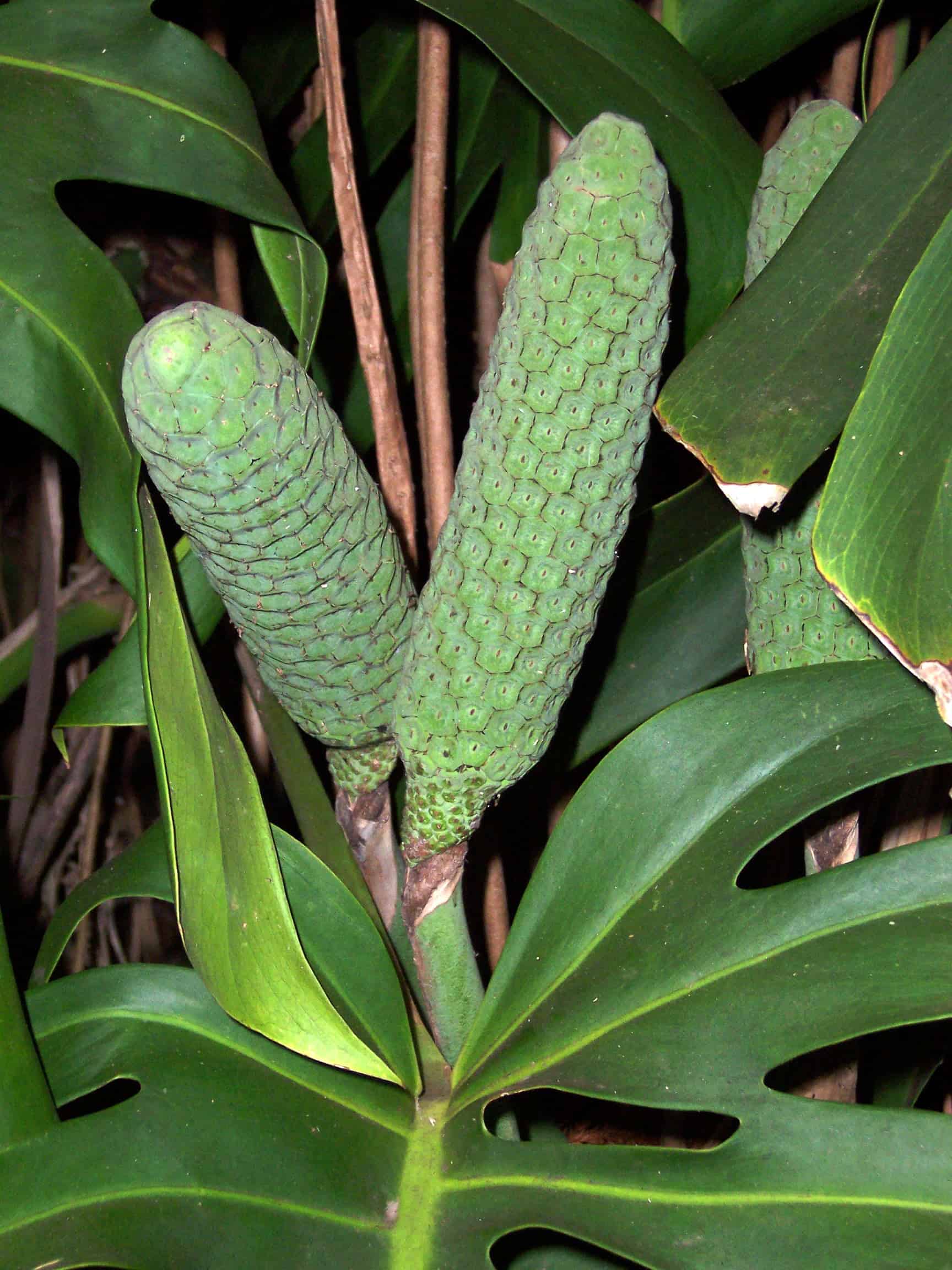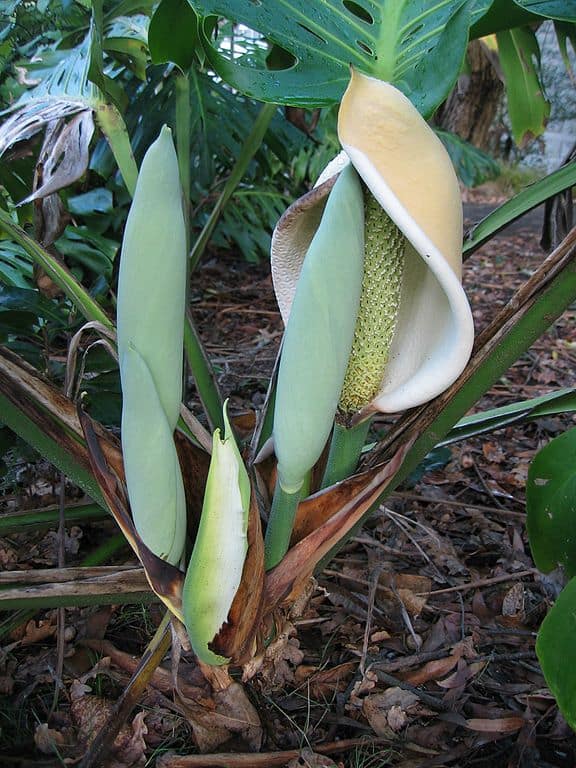Have you ever thought about eating the oblong-shaped fruit from your Monstera deliciosa? If YES, then I should warn you that this uniquely shaped fruit is life-threateningly toxic.
However, it does not mean you cannot relish the delicious fruit and enjoy its many nutritional benefits.
Monstera deliciosa fruit boasts varying banana, strawberry, and passion fruit flavors. It contains a significant amount of phosphorus, vitamin C, protein, fat, and fiber to meet your daily nutritional meal value.

However, be wary about harvesting or eating the fruit before it ripens, as you may risk poisoning yourself.
Read on to find out what different nutritional values and benefits your regular houseplant fruit serves and how to eat it best.
Table of Contents
- Where can you Buy Monstera Deliciosa Fruit?
- Benefits of Monestra Deliciosa Fruits
- 1. Rich Taste and Aroma
- 2. Nutritional Value
- 3. Good for Instant Energy
- 4. Recovery from Radiotherapy Treatment
- 5. Improve Bowel movement
- Is the Monstera Deliciosa Fruit Toxic?
- When to Eat Monstera Deliciosa Fruit
- How to Eat Monstera Deliciosa Fruit?
- Conclusion
Where can you Buy Monstera Deliciosa Fruit?
Getting your hands on Monstera deliciosa fruit may not be as easy as finding other popular fruits. It is mainly because indoor-grown Monstera fails to produce edible fruits.
Growers specializing in personal gardening would not produce enough fruits for sale; hence, you need to rely on a few sellers.
You can easily find deliciosa fruit in the market if you reside in or around Southern Mexico, Costa Rica, Nicaragua, Guatemala, and Belize, the native habitat of the Monstera plant.

Do not be surprised if you have to pay a hefty price for a handful of deliciosa fruits, ranging from $100 to $200.
Miami Fruit is a seller who would be willing to sell you Monstera fruits. They are the one-stop shop for all kinds of exotic and tropical fruits in the US.
As the fruit may not be available around the year, you should place a pre-order on the website. You can also check out their Tropical Fruit Ripening Guide.
They take orders from small (3-5 lbs) to large boxes (7-10 lbs) with accordingly different price ranges. The small box costs $127, and the Large box costs $197.
You can also order in bulk, and it will be shipped within 1-2 weeks in the season.
Pro Tip: Get in touch with local nurseries in your area to check whether they grow Monstera deliciosa for the fruits.
Benefits of Monestra Deliciosa Fruits
They offer a lot more benefits in terms of nutrition and taste that sets them apart from many other tropical fruits. Here is a list of the benefit of Monstera deliciosa fruit.
1. Rich Taste and Aroma
This tropical species is not easy to grow for its fruits, but once it does, it gives a high taste value to each fruit.
Fruits Info points out that the Monstera fruit gives a multitude of tastes depending on when it is harvested.
Did you know the title “Deliciosa” came after the delicious Monstera fruit that tastes and smells lovely when ripened?
On the first day, its flavor tastes like guava, then mangosteen, lychee, passion fruit taste, sweetsop fruit, and grape on each consecutive day.
However, the best flavor is obtained on the ninth day when the fruit perfectly ripens, giving a sweet aroma.

2. Nutritional Value
The Monstera deliciosa is a life-saving plant offering a handful of benefits to the parent.
Their leaves effectively trap dust and air-borne toxins like toluene and formaldehyde from ending up in your lungs.
Imagine what its fruit can do to your health. The juicy tropical plant is full of macro and micro minerals that top the daily nutrition chart.
Here is a brief nutritional chart of the Monstera deliciosa fruit served per 100 gm.
| Principle | Nutritional Value |
|---|---|
| Fats | 1g |
| Protein | 23g |
| Carbohydrates | 32g |
| Calcium | 16g |
| Thiamin | 0.01mg |
| Phosphorus | 10g |
| Fiber | 0.4g |
| Vitamin C | 60g |
| Calories | 10g |
National Institute of Health points out that an adult should take 65-90mg of Vitamin C each day.
Isn’t it good that deliciosa fruit per 100gm provides ample vitamin C?
3. Good for Instant Energy
Monstera deliciosa fruit is loaded with lots of Vitamin C.
It contains a surplus amount of Protein, Vitamin C, Phosphorus, and Carbohydrates that provides an instant energy boost.
Vitamin C is an excellent antioxidant that helps treat fatigue and stress by boosting endorphins.

In fact, it contains a lot of good carbs, some Vitamin B, and almost no fat, which makes it a perfect fruit item to relish daily.
It makes a perfect energy supplement for athletes going for a run, swim, or a bike ride.
4. Recovery from Radiotherapy Treatment
Experts advise people rehabilitating after radiation treatment to gobble up nutritious and fulfilling meals that help heal tissues and fight infection.
Deliciosa fruit would make a perfect fruit to have after radiotherapy to help boost rich antioxidants in the body.
Along with low-fat meat, fresh beans, lentils, and soy products, fruits like Monstrea are mostly recommended for their antioxidant and nutritional properties.
Moreover, it will provide essential macro and micronutrients to help regenerate and heal tissues.
5. Improve Bowel movement
Eating seasonal fruits is known to induce gastrointestinal juices that will help with improving bowel movement.
WebMD points out that eating fruits daily helps with relieving constipation naturally.
Monstera deliciosa fruit contains many micro minerals, fibers, and antioxidant properties that will help with improving your bowel movement.
Is the Monstera Deliciosa Fruit Toxic?
Monstera, which comes from the word “Monster,” boasts delicious fruits considered a delicacy in many parts of the world, but they are also toxic.
You have heard it right! All species of Monstera plant are toxic and so do their leaves, stems, and fruits.
Monstera deliciosa produces a resin called calcium oxalate crystals (insoluble) that is highly toxic and may easily poison humans and animals when they come in contact.
The deliciosa fruit may also produce toxins Proteinase and Proteolytic enzyme that releases poisonous agents like histamines and kinins that does severe bodily damage.
Find out if your Highly beneficial and aesthetic looking Monstera is Toxic to Dogs.
When to Eat Monstera Deliciosa Fruit
Before you eat Monstera deliciosa fruit, you should check whether the fruit has ripened and is suitable for consumption.
Typically, Monstera Deliciosa would start producing fruits after producing blossoms, which would take a year to become fully ripe.
Fruit is usually ready to eat in the fall or winter of the following year after it starts growing.

Since the toxin only resides in an unripened Monstera fruit.
Wait until the greenish scales begin naturally falling off or can easily be brushed off using your fingers. Eat only the white part that resides just below the greenish scales.
Beware of eating unripe fruits as the calcium oxalate crystals may affect sensitive tissues inside your mouth, tongue, throat, and digestive tract.
Touching the sap with naked skin may lead to itchiness, rashes, and stinging, while consuming the unripe fruit could cause nausea, vomiting, and diarrhea.
Once fully mature, the fruits can grow up to 10 or 12 inches long and give a greenish texture with hexagonal scales.
How to Eat Monstera Deliciosa Fruit?
There are multiple ways to relish this delicious, exotic fruit. Here are a few ways you can enjoy Monstera deliciosa fruit.
- Remove the greenish scales and bite off the juicy white parts.
- Prepare a homemade jam using the fruit extracts and serve it with toast, ice cream, or pancakes.
- Cut the fruit into bit sizes and freeze them in freezer bags to enjoy frozen fruit cuttings.
- Dice the fruit into small pieces and mix with other tropical fruits to create a fruit platter or salad.
Conclusion
Monstera deliciosa fruit is a gem of tropical fruit that you should not miss.
Order a fresh batch online or grow one yourself at home using the Monstera growing guide to obtain delicious exotic fruits.
However, beware of eating unripe Monstera deliciosa fruit, which is equally dangerous to your health.
Did you know all the astonishing health benefits of Avocado? Well here are some researched Incredible Health Benefits of Avocado.